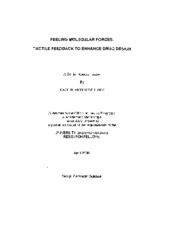| dc.creator | Williams, Jocylin Amber | |
| dc.date.accessioned | 2013-02-22T20:39:40Z | |
| dc.date.available | 2013-02-22T20:39:40Z | |
| dc.date.created | 2000 | |
| dc.date.issued | 2013-02-22 | |
| dc.identifier.uri | https://hdl.handle.net/1969.1/ETD-TAMU-2000-Fellows-Thesis-W345 | |
| dc.description | Due to the character of the original source materials and the nature of batch digitization, quality control issues may be present in this document. Please report any quality issues you encounter to digital@library.tamu.edu, referencing the URI of the item. | en |
| dc.description | Includes bibliographical references (leaf 8). | en |
| dc.description.abstract | Molecular modeling is a vital component for structure-based drug design. Currently implemented technology combines data and graphics to give the user visual capabilities to assist in discovering possible binding arrangements. Visual modeling has become a tremendous help to scientists in reducing the amount of time needed to create new inhibitory compounds. However, the visual medium used for modeling lacks the ability to convey the forces between the molecules to the user. Potentially, tactile feedback can provide this missing information. SensAble Devices has developed a device capable of producing force feedback to a user-defined environment called the PHANToM, The PHANToM is a 6 dimensional (3 translational and 3 rotational) haptic device that can return force and torque to the user through a hand held stylus. The system configuration for molecular modeling consists of integrating the haptic device with a high-end PC running Windows NT and developing code to model the intermolecular forces. The programming language used was C with some C++ constructs and the OpenGL graphics library for the graphics implementation. The optimized code running with the system has proven capable of calculating and relaying tactile feedback between a 100-atom active site of a protein and a small 15-atom inhibitor in real time (ca. 1 millisecond). Trials are now underway on the system to evaluate accuracy and explore other forms of useful output. Once this is accomplished, modeling will be done on an active site and an untested inhibitor to evaluate novel binding modes. | en |
| dc.format.medium | electronic | en |
| dc.format.mimetype | application/pdf | |
| dc.language.iso | en_US | |
| dc.publisher | Texas A&M University | |
| dc.rights | This thesis was part of a retrospective digitization project authorized by the Texas A&M University Libraries in 2008. Copyright remains vested with the author(s). It is the user's responsibility to secure permission from the copyright holder(s) for re-use of the work beyond the provision of Fair Use. | en |
| dc.subject | computer science. | en |
| dc.subject | Major computer science. | en |
| dc.title | Feeling molecular forces: tactile feedback to enhance drug design | en |
| thesis.degree.department | computer science | en |
| thesis.degree.discipline | computer science | en |
| thesis.degree.name | Fellows Thesis | en |
| thesis.degree.level | Undergraduate | en |
| dc.type.genre | thesis | en |
| dc.type.material | text | en |
| dc.format.digitalOrigin | reformatted digital | en |


